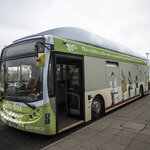Energy

Sometimes the whole is greater than the sum of its parts, said Aristotle. That certainly applies to biology, where molecular motions in living systems have a macroscale effect - such as large muscles that contract due to protein motors.
A team at CNRS's Institut Charles Sadron led by Nicolas Giuseppone, professor at the Université de Strasbourg has used this concero to make a polymer gel that is able to contract through the action of artificial molecular motors. When activated by light, these nanoscale motors twist the polymer chains in the gel, which as a result contracts by several…

In the future, if we use money to fund basic research for solar and stop subsidizing existing technology that does not work very well, there will be no energy crisis. In the time it takes you to read this article, the sun will provide enough energy to power the planet for a year.
But that does not translate to everything. An international group of scientists has noted once again that "renewable" is not synonymous with "unlimited."
To make the point that existing renewables may be maxed out, researchers from Michigan State University (MSU), the Helmholtz Centre for Environmental Research…

Biofuels have long been studied and, like many alternative fuels, given corporate subsidies by the government, but they haven't made much progress. And that isn't just because subsidies discourage innovation, it is because of biology. Lignin, which helps cell walls thick in plants, is tough.
Plant geneticists have discovered the gene regulatory networks that control cell wall thickening by the synthesis of the cellulose, hemicellulose and lignin. If they can know it, and understand it, they can modify it, and that may mean viable biofuels.
Lignin is the major impediment to extracting…

A thin sheet of graphene wrapped around a new multifunctional sulfur electrode that combines an energy storage unit and electron/ion transfer networks could lead to a promising design for rechargeable lithium-sulfur batteries.
Lithium-sulfur batteries are of great commercial interest because they boast theoretical specific energy densities considerably greater than those of their already-well-established cousin, lithium ion batteries. And we clearly need battery improvements, there hasn't been anything substantial for 25 years.
A team of researchers led by Dr. Vasant Kumar at the University…

Windows with
transparent photovoltaic modules or façades in which microalgae are being bred to provide the house with its own biofuel are just some of the aspects buildings of the future could feature.
A new international research effort, coordinated by Friedrich Schiller University in Jena’s materials scientist Lothar Wondraczek, is aiming to change this. In the project ‘Large-Area Fluidic Windows – LaWin’ the scientists intend to develop functional façades and window modules, together with an integrated production process to achieve an as to yet unmatched readiness to market.
“…

Though the New York governor recently made a pretense of banning fracking in the state (it was already not allowed) and the California governor said they should do the same thing, they're both being a little hypocritical. New York would have brown-outs without the energy they buy from Pennsylvania fracking and California has no fracking and 50 percent higher utility costs than the rest of the country because they subsidize alternatives and have to buy so heavily on the spot market.
American CO2 levels are down and while some contend it is more due to federal economic mismanagement and…

Leading conservationists from around the world have called for environmental lobbyists to stop blocking nuclear energy in defiance of the science consensus. It's clean, it's green, and it's needed to mitigate climate change and protect biodiversity.
In an open letter to environmentalists, over 60 scientists ask the environmental community to "weigh up the pros and cons of different energy sources using objective evidence and pragmatic trade-offs, rather than simply relying on idealistic perceptions of what is 'green'".
Organized by ecologists Professor Barry Brook and Professor Corey Bradshaw…

Despite the high capital costs, nuclear ticks boxes. Kaissa
By Malcolm Grimston, Imperial College London
An experiment in liberalizing power markets has been underway in the UK since the 1980s and three phases can be identified. The first ran from around 1989 to 1999, beginning with the privatization of the generating industry and grid and ending by giving customers the freedom to shop around for their supplier.
When liberalization proper started in 1999 the system was well supplied – even oversupplied – with generating capacity. So the next stage was one of cut-throat competition for market…

Wind farms like this one probably wouldn't exist if the government didn't provide a hefty subsidy. Shutterstock
By Randy Simmons, Utah State University
Congress passed the wind production tax credit (PTC) more than two decades ago to spur development in an industry still in its infancy. The wind sector has since matured into adulthood, prompting thousands of turbine farms to sprout in fields across the country.
The credit, worth 2.3 cents per kilowatt hour of wind electricity produced, expired at the end of 2013 but is being considered for renewal as part of a package of tax breaks that…

All aboard. Ben Birchall/PA
By Sarah Jewitt, University of Nottingham
A British “poo bus” went into service last week, powered by biomethane energy derived from human waste at a sewage plant.
For those of us who follow these matters – and my academic works include Geographies of Shit: Spatial and temporal variations in attitudes towards human waste – this was an exciting moment, a rare piece of good PR for human waste. After all, most societies strongly associate it with a sense of disgust. Poo threatens the health of around 2.5 billion people … and it smells bad.
Yet it also represents an…